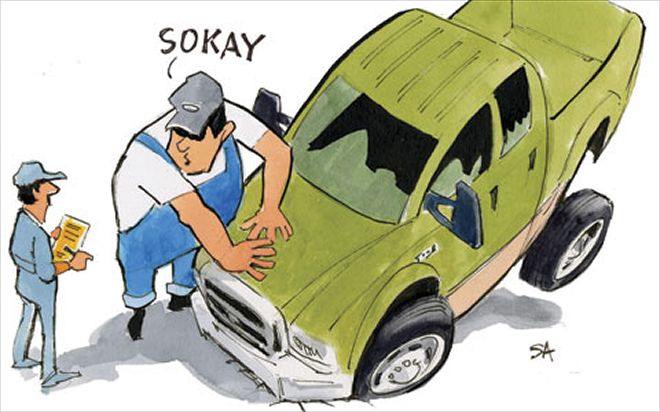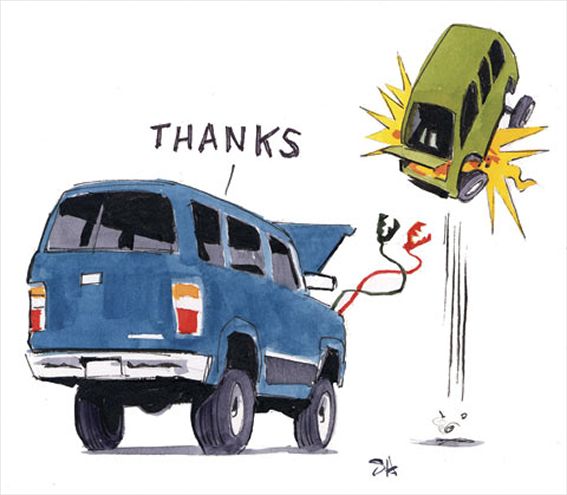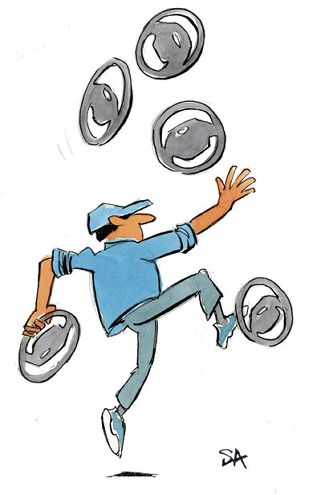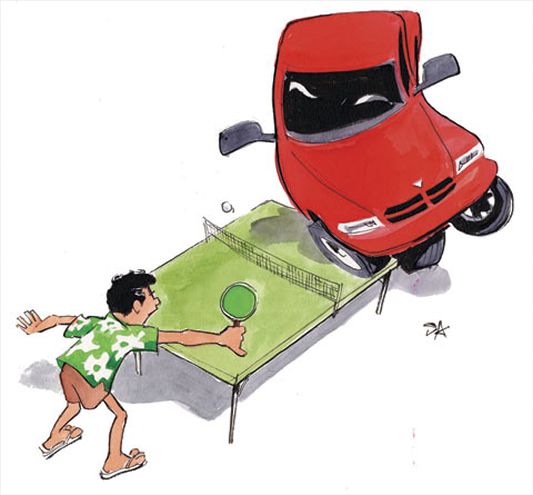New Shocks for My TruckQ: I tow a 12,000-pound fifth-wheel trailer with my 1999 F-250 Super Duty. How many towing miles should I get out of a set of shocks? How can I tell when I need new shocks? You can't push on the bumper to tell, as you can with a car.

| 136 0510 Ttg01 Z
A: On a lighter vehicle, you can push down on a fender or quarter-panel to observe the rebound of the suspension to help determine basic shock-absorber function. If the suspension freely bounces up and down a few times, the shock(s) are no longer damping suspension travel and are ready for replacement. It would require a really big guy to jounce the suspension of a 3/4-ton truck. So, the best choice is a careful visual inspection and a road test by a qualified technician. On the highway, you're looking for excessive sway on turns or a continued up-and-down bounce after passing over a dip in the road. Visually inspect each shock for leaks. There may be a darkened moist area near the sealed end of the shock. This is considered normal fluid evaporation and doesn't warrant replacement. A significant leak will produce a stream down the side and/or droplets hanging from the bottom. Also be sure all fastening bolts and nuts are secure, bushings are in good condition, and nothing is bent or damaged. This usually covers the bases, but you can take it a step further by unbolting one end of a shock and then manually expanding and contracting it. A good shock will produce a smooth, steady hydraulic resistance. However, this check doesn't apply to the Super Duty's gas-pressurized shocks. There's no shock replacement specified in the manufacturer's recommended maintenance schedules. However, if you have long-term plans for the vehicle, I'd suggest replacement when nearing the 100,000-mile mark. Also, there are a number of good aftermarket shock absorbers that may improve ride and handling from factory protocol.
Show Me Your FittingsQ: I do all the maintenance on my 2001 Expedition. During oil changes, I can only find two grease fittings, both of which appear to be on the idler arm. Am I missing any other fittings on this vehicle? All other ball joints appear to be sealed.
A: Any ball joints or steering linkages (tie-rod ends, idler arm, pitman arm, etc.) that don't have grease fittings are factory-sealed units that don't require periodic lubrication. Carefully inspect each part to be sure there are no holes where a fitting may have broken or fallen off. Inspection of all suspension parts (sealed or not) is part of the manufacturer's maintenance schedule. In fact, you should have received a customer maintenance reminder letter from Ford focusing on, and including, an updated tie-rod inspection procedure. This type of notification is typically due to an issue with premature wear. Be sure that none of the rubber seals are punctured or are retaining water and that the inner and outer tie-rod ends show no signs of freeplay or corrosion. Each suspension and steering part is different. For instance, a tie-rod end should be replaced if any sign of freeplay is noted, but the idler arm will have a normal amount of freeplay that shouldn't exceed 5 mm. To accurately inspect ball-joint freeplay, support the suspension at a specified location to relieve spring tension. The maintenance reminder also recommends a visit to a Ford service department. If you haven't received a copy of the reminder, call Ford customer service at 866/436-7332. If you want to do the work yourself, buy an Expedition service manual.
Tracking Down the HumQ: I have a 2004 Chevrolet Trailblazer LT. I love the ride and look of the truck, but have experienced a persistent humming coming out of the dash, usually between 1300 and 1500 rpm. I've taken the SUV to the dealer three times: Once I was told it was normal, the second time they replaced a hood latch, which fell under a service notice, and the third time, they replaced and reprogrammed the IPC. They said the "stepping motor" in the dash was bad. The humming was gone for two or three days, but returned and seems more pronounced when cold.

| 136 0510 Ttg02 Z
A: There are two routes to pursue on this one. First, double-check the history behind the instrument-panel cluster, which the service department has already installed. General Motors has encountered noise issues from the IPC on a number of cars, trucks, and SUVs. The noise is actually coming from the stepper motor, part of the tachometer, and typically changes tone with engine speed (tachometer reading). Instrument-panel replacement is accomplished through an exchange program with an electronics subcontractor. GM has notified the contractors of the problem, which requires replacement of the stepper motor within the cluster. However, if the dealership's parts department didn't define the noise as the problem, the contractor may very well have given you an exchange cluster with another noisy stepper motor. Once that's eliminated as a possible cause, it may require a road test after partial disassembly of the dash, with the appropriate listening device, to track down the source of the noise.
Traumatic Jump SyndromeQ: I recently used my 1997 Pontiac Trans Sport to jumpstart my Suburban, which did severe damage to the Pontiac's electrical system. The truck runs, but voltage is pulsating on every electrical part at a rate of about 60 times per minute. I have been told there are about three circuit boards that may be affected. Where do I start looking? The van will run, but sometimes keeps running after the ignition switch is off. When I turn on the headlights, it seems to short circuits out and will eventually stop the engine from running.
A: In general, correctly jumpstarting another vehicle shouldn't damage electrical components. Get it to a qualified shop for diagnosis. Inspect all positive and negative connections to the battery and alternator, especially the battery terminals. Something may have been disturbed while boosting the Suburban. Then, with proper testing equipment, fully test the performance of the battery and charging system. The electrical pulsations (I presume you're referring to lights going bright and dim or the voltmeter reading high, then low) may be caused by intermittent operation of the alternator due to an internal failure or a poor external electrical connection. Turning on the lights may pull the battery voltage down below a usable margin for the PCM (the engine's computer). The engine will shut down at that point. The trouble may be from another area altogether--figuring it out yourself may get you nowhere fast.
Out Go the LightsQ: My 2000 Silverado's dash lights occasionally go out, killing the speedometer and tachometer. This also causes the transmission to stick in third gear. Could the ignition switch be causing these problems? The truck has 113,000 miles on it.
A: Good call. The ignition switch has caused some grief for several GM trucks. Symptoms include the instrument cluster going dead, the malfunction indicator lamp coming on, and the transmission becoming stuck in third gear. Check the 10-amp ignition fuse labeled #5 in the fuse block, located at the lower left-hand side of the instrument panel. If there's no voltage applied to the fuse with the ignition switch in the run position, the problem is most likely the switch. But keep in mind that a glitch in an aftermarket remote starter or alarm system can cause the same condition. If there's power to the fuse from the ignition switch, and the fuse is good, then there's probably a break in the circuit after the fuse. The ignition switch itself costs about $100, and replacement is a somewhat involved procedure that requires disassembly of the steering column.

| 136 0510 Ttg03 Z
Super Duty Steering FixQ: I have a crew-cab, shortbed 4WD 2005 Ford F-250 Super Duty with the Power Stroke diesel and automatic, which I purchased new. When one of the truck's wheels hits a bump, manhole, pothole, or uneven pavement, there's serious feedback in the steering wheel. My dealer couldn't find anything wrong, yet Ford later issued a service bulletin. After taking it in for the necessary upgrades, including a new steering wheel, there's no notable difference in feedback. I repeatedly brought the truck back to the dealer, which has been cooperative, but with each visit tightened the steering gear until my Ford became undrivable. I returned again, and they loosened the gear, but the feedback is still there.
A: That's a surprising problem, considering the ride, handling, and maneuverability improvements provided by suspension upgrades to the 2005 Super Duty. On 4x2 and 4x4 models, Ford did away with the front leaf springs, replacing them with coil springs and a superior steering configuration. Our experience with the new model has been positive. Technical service bulletin 04-26-1 gives step-by-step instructions for evaluating and correcting steering-wheel oscillation over bumps on certain 2005 Super Duty trucks. Part of the procedure is to replace the steering wheel, inspect the steering damper, and adjust the steering gear (box). First and foremost, check and double-check the tire pressure. Too many people set air pressure at the tire's maximum limit, which is printed on the sidewall. Adhere to the manufacturer's recommended tire pressures listed on the tag within the driver's doorjamb, fuel door, or glovebox (always check pressure when the tires are cold). Ford engineers calculate these numbers to provide optimum ride, handling, tire wear, and safety, even while carrying a maximum-rated cargo load. Higher pressures may give a stiffer ride with steering feedback. You also may want to drive a similar truck to ensure you're not experiencing a normal ride characteristic. After that, make sure the technicians executed every phase of the TSB. They also should be discussing the problem with Ford technical assistance. I'll keep my eye out for any new service bulletins related to the condition.
Dodge V-6 Ping-PongQ: My 1996 Dodge Dakota's 3.9-liter V-6 is pinging. About a year ago, it would intermittently ping and run rough. When I stepped on the accelerator it would shake and vibrate, wouldn't idle right, and, when going around a turn, would die. I'm afraid of something like this happening again. The last time I took it in, the dealership found a bad MAP sensor. Is it possible for the cause to be the MAP sensor again after only a year, or might there be a completely new problem?

| 136 0510 Ttg04 Z
A: Next time you bring it into the shop, ask the technicians to check for conditions common to a wide range of Dodge engines, including the 3.9-liter V-6. One is ignition-wire routing. There's a procedure for rerouting and insulating the ignition wires to eliminate a possible misfire or spark knock. Next, they should explore the intake-manifold plenum pan gasket. This gasket, located within the crankcase, may initiate an internal vacuum leak, which will consume oil, cause pinging and misfiring, and miscellaneous trouble codes. Any Dodge service department will know exactly which route to take once you explain the condition.
Purging Diesel AirQ: My Duramax started having problems after I changed the fuel filter. I double-checked that the gasket on the fuel filter was seated properly. The only way I can get the truck started is to warm the fuel filter with my wife's hairdryer for about an hour. Once I do that, the truck starts and runs fine--until I shut it down and it sits for three to four hours. Gale Banks installed a Stinger power pack and exhaust brake about two weeks ago, but this didn't cause any starting problems.
A: That's one of the differences between servicing the fuel systems on gasoline versus diesel-powered engines. The gas engine will fire right up after air has been added to the system due to fuel component replacement--a diesel won't. Diesel engines require a purge or priming procedure to get all of the air out of the system, enabling a quick post-service startup. You didn't give me your specific Chevy/GMC truck application, so I can't spell out the exact procedure. Some use a primer setup located on top of the fuel filter, which you should pump 30 times after filter replacement. Purchase the appropriate service manual and learn the ropes, or get it to a qualified shop with diesel experience. Hopefully, air is the only thing holding you back.
How To Reach AlexIf you have a technical question regarding your pickup, SUV, or van, feel free to contact Alex, a master technician with the National Institute for Automotive Service Excellence. Send a letter to him in care of Truck Trend Garage, 831 S. Douglas Street, El Segundo, CA 90245, or e-mail us at
[email protected]. Please include the VIN with your question. Due to the volume of questions received every month, we cannot guarantee that everyone's question will be personally answered or will appear in the magazine.
Can't wait for help with a problem you're having with your Truck or SUV? Ask the expert we trust here at Truck Trend Garage--visit Alex Steele at www.RealWorldAutomotive.com.
 | 136 0510 Ttg01 Z
A: On a lighter vehicle, you can push down on a fender or quarter-panel to observe the rebound of the suspension to help determine basic shock-absorber function. If the suspension freely bounces up and down a few times, the shock(s) are no longer damping suspension travel and are ready for replacement. It would require a really big guy to jounce the suspension of a 3/4-ton truck. So, the best choice is a careful visual inspection and a road test by a qualified technician. On the highway, you're looking for excessive sway on turns or a continued up-and-down bounce after passing over a dip in the road. Visually inspect each shock for leaks. There may be a darkened moist area near the sealed end of the shock. This is considered normal fluid evaporation and doesn't warrant replacement. A significant leak will produce a stream down the side and/or droplets hanging from the bottom. Also be sure all fastening bolts and nuts are secure, bushings are in good condition, and nothing is bent or damaged. This usually covers the bases, but you can take it a step further by unbolting one end of a shock and then manually expanding and contracting it. A good shock will produce a smooth, steady hydraulic resistance. However, this check doesn't apply to the Super Duty's gas-pressurized shocks. There's no shock replacement specified in the manufacturer's recommended maintenance schedules. However, if you have long-term plans for the vehicle, I'd suggest replacement when nearing the 100,000-mile mark. Also, there are a number of good aftermarket shock absorbers that may improve ride and handling from factory protocol.
Show Me Your Fittings
| 136 0510 Ttg01 Z
A: On a lighter vehicle, you can push down on a fender or quarter-panel to observe the rebound of the suspension to help determine basic shock-absorber function. If the suspension freely bounces up and down a few times, the shock(s) are no longer damping suspension travel and are ready for replacement. It would require a really big guy to jounce the suspension of a 3/4-ton truck. So, the best choice is a careful visual inspection and a road test by a qualified technician. On the highway, you're looking for excessive sway on turns or a continued up-and-down bounce after passing over a dip in the road. Visually inspect each shock for leaks. There may be a darkened moist area near the sealed end of the shock. This is considered normal fluid evaporation and doesn't warrant replacement. A significant leak will produce a stream down the side and/or droplets hanging from the bottom. Also be sure all fastening bolts and nuts are secure, bushings are in good condition, and nothing is bent or damaged. This usually covers the bases, but you can take it a step further by unbolting one end of a shock and then manually expanding and contracting it. A good shock will produce a smooth, steady hydraulic resistance. However, this check doesn't apply to the Super Duty's gas-pressurized shocks. There's no shock replacement specified in the manufacturer's recommended maintenance schedules. However, if you have long-term plans for the vehicle, I'd suggest replacement when nearing the 100,000-mile mark. Also, there are a number of good aftermarket shock absorbers that may improve ride and handling from factory protocol.
Show Me Your Fittings | 136 0510 Ttg02 Z
A: There are two routes to pursue on this one. First, double-check the history behind the instrument-panel cluster, which the service department has already installed. General Motors has encountered noise issues from the IPC on a number of cars, trucks, and SUVs. The noise is actually coming from the stepper motor, part of the tachometer, and typically changes tone with engine speed (tachometer reading). Instrument-panel replacement is accomplished through an exchange program with an electronics subcontractor. GM has notified the contractors of the problem, which requires replacement of the stepper motor within the cluster. However, if the dealership's parts department didn't define the noise as the problem, the contractor may very well have given you an exchange cluster with another noisy stepper motor. Once that's eliminated as a possible cause, it may require a road test after partial disassembly of the dash, with the appropriate listening device, to track down the source of the noise.
Traumatic Jump Syndrome
| 136 0510 Ttg02 Z
A: There are two routes to pursue on this one. First, double-check the history behind the instrument-panel cluster, which the service department has already installed. General Motors has encountered noise issues from the IPC on a number of cars, trucks, and SUVs. The noise is actually coming from the stepper motor, part of the tachometer, and typically changes tone with engine speed (tachometer reading). Instrument-panel replacement is accomplished through an exchange program with an electronics subcontractor. GM has notified the contractors of the problem, which requires replacement of the stepper motor within the cluster. However, if the dealership's parts department didn't define the noise as the problem, the contractor may very well have given you an exchange cluster with another noisy stepper motor. Once that's eliminated as a possible cause, it may require a road test after partial disassembly of the dash, with the appropriate listening device, to track down the source of the noise.
Traumatic Jump Syndrome | 136 0510 Ttg03 Z
Super Duty Steering Fix
| 136 0510 Ttg03 Z
Super Duty Steering Fix | 136 0510 Ttg04 Z
A: Next time you bring it into the shop, ask the technicians to check for conditions common to a wide range of Dodge engines, including the 3.9-liter V-6. One is ignition-wire routing. There's a procedure for rerouting and insulating the ignition wires to eliminate a possible misfire or spark knock. Next, they should explore the intake-manifold plenum pan gasket. This gasket, located within the crankcase, may initiate an internal vacuum leak, which will consume oil, cause pinging and misfiring, and miscellaneous trouble codes. Any Dodge service department will know exactly which route to take once you explain the condition.
Purging Diesel Air
| 136 0510 Ttg04 Z
A: Next time you bring it into the shop, ask the technicians to check for conditions common to a wide range of Dodge engines, including the 3.9-liter V-6. One is ignition-wire routing. There's a procedure for rerouting and insulating the ignition wires to eliminate a possible misfire or spark knock. Next, they should explore the intake-manifold plenum pan gasket. This gasket, located within the crankcase, may initiate an internal vacuum leak, which will consume oil, cause pinging and misfiring, and miscellaneous trouble codes. Any Dodge service department will know exactly which route to take once you explain the condition.
Purging Diesel Air